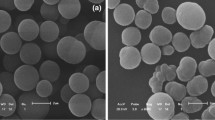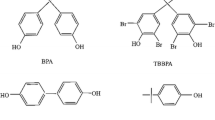Abstract
Using hepatoprotective component silybin as the template, MAA as the functional monomer, EGDMA as the cross linker, acetonitrile as the solvent, and Fe3O4 as the magnetic substrate, the silybin magnetic molecularly imprinted polymer(S-MIP) was successfully prepared by the reverse atom transfer radical precipitation polymerization(RATRP), and non-ion imprinted polymer(NIP) was also synthesized by the same procedure only in the absence of silybin. On the basis of computer simulation and L9(34) orthogonal array design matrix, the optimal preparation conditions were finally obtained as follows that the molar ratio of silybin, MAA, and EGDMA was 1:5:60. The prepared materials were respectively characterized by SEM, XRD, FT-IR, VSM and TGA, and the kinetic analyses explored that the adsorption process of S-MIP was better describled by the pseudo-second order kinetic equation, meanwhile, scatchard analysis illustrated that the heterogeneous binding sites existed in S-MIP. Both the selectivity factor α (2.232) and the relative selectivity factor β (2.201) of S-MIP showed the aim material had the excellent specific recognition capacity and selection adsorption property to silybin. Additionally, the recycling reuse experiments explored S-MIP was of a good stability and could be used repeatedly at least five times with only 15.8% decrease of adsorption capacity when applied in the fifth experiment, and the evaluation experiments by HPLC for silybin extraction from the medicinal herb milk thistle seeds indicated that S-MIP had the potential application in separating the natural hepatoprotective component silybin from the herbal plants.















Similar content being viewed by others
References
Fibigr J, Satinsky D, Solich (2017) A new approach to the rapid separation of isomeric compounds in a Silybum marianum extract using UHPLC core-shell column with F5 stationary phase. J Pharm Biomed Anal 134: 203–213
Kiruthiga PV, Shafreen RB, Pandian SK, Arun S, Govindu S, Devi KP (2007) Protective effect of silymarin on erythrocyte haemolysate against benzo (a) pyrene and exogenous reactive oxygen species (H2O2) induced oxidative stress. Chemosphere 68:1511–1518
Kumar T, Larokar YK, Iyer SK, Kumar A, Tripathi DK (2011) Phytochemistry and pharmacological activities of Silybum marianum: a review. Int J Pharm Phytopharmacol Res 1:124–133
Asghar Z, Masood Z (2008) Evaluation of antioxidant properties of silymarin and its potential to inhibit peroxyl radicals in vitro. Pak J Pharm Sci 21:249–254
Federico A, Dallio M, Loguercio C (2017) Silymarin/Silybin and chronic liver disease: a marriage of many years. Molecules 22:191–207
Tang Y, Gao J, Liu X, Xue G, Tao M, Lu X (2017) Ultrasensitive detection of clenbuterol by a covalent imprinted polymer as a biomimetic antibody. Food Chem 228:62–69
Liu H, Fang G, Zhu H, Wang S (2014) Application of molecularly imprinted polymer appended onto cdse/zns quantum dots for optosensing of tocopherol in rice. Food Anal Methods 7(7):1443–1450
Sarafraz-Yazdi A, Razavi N (2015) Application of molecularly-imprinted polymers in solid-phase microextraction techniques. TrAC Trends Anal Chem 73:81–90
Li L, Chen L, Zhang H, Yang Y, Liu X, Chen Y (2016) Temperature and magnetism bi-responsive molecularly imprinted polymers: preparation, adsorption mechanism and properties as drug delivery system for sustained release of 5-fluorouracil. Mater Sci Eng C 61:158–168
Cheong WJ, Yang SH, Ali F (2013) Molecular imprinted polymers for separation science: a review of reviews. J Sep Sci 36:609–628
Ahmad R, Griffete N, Lamouri A, Felidj N, Chehimi MM, Mangeney C (2015) Nanocomposites of gold nanoparticles@molecularly imprinted polymers: chemistry, processing, and applications in sensors. Chem Mater 27:5464–5478
Atar N, Yola ML, Eren T (2016) Sensitive determination of citrinin based on molecular imprinted electrochemical sensor. Appl Surf Sci 362:315–322
Sheykhaghaei G, Hossainisadr M, Khanahmadzadeh S, Seyedsajadi M, Alipouramjad A (2016) Magnetic molecularly imprinted polymer nanoparticles for selective solid phase extraction and pre-concentration of Tizanidine in human urine. J Chromatogr B: anal Technol biomed Life Sci 1011 1–5
Tang Y, Gao J, Liu X, Lan J, Gao X, Ma Y, Li M, Li J (2016) Determination of ractopamine in pork using a magnetic molecularly imprinted polymer as adsorbent followed by HPLC. Food Chem 201:72–79
Chang L, Chen S, Li X (2012) Synthesis and properties of cre-shell magnetic molecular imprinted polymers. Appl Surf Sci 258:6660–6664
Tang Y, Liu H, Gao J, Liu X, Gao X, Lu X (2018) Upconversion particle@Fe3O4@molecularly imprinted polymer with controllable shell thickness as high-performance fluorescent probe for sensing quinolones. Talanta 181:95–103
Adali-Kaya Z, Tse-Sum-Bui B, Falcimaigne-Cordin A, Haupt K (2015) Molecularly imprinted polymer nanomaterials and nanocomposites: atom-transfer radical polymerization with acidic monomers. Angew Chem Int Ed Engl 54:5192–5195
Wang HS, Song M, Hang TJ (2016) Functional interfaces constructed by controlled/living radical polymerization for analytical chemistry. ACS Appl Mater Interfaces 8:2881–2898
Qiu X, Wu Y, Chen D, Lai L, Liang Y, Guo H (2016) Fabrication of novel stir bar Sorptive extraction coating based on magnetic molecularly imprinted polymer through atom transfer radical polymerization for trace analysis of estrogens in milk. J Nanosci Nanotechnol 16:12374–12381
Chen N, He J, Wu C, Li Y, Suo A, Wei H, He L, Zhang S (2017) Synthesis of molecularly imprinted polymers by atom transfer radical polymerization for the solid-phase extraction of phthalate esters in edible oil. J Sep Sci 40:1327–1333
Dai J, Zou Y, Zhou Z, Dai X, Pan J, Yu P, Zou T, Yan Y, Li C (2014) Narrowly dispersed imprinted microspheres with hydrophilic polymer brushes for the selective removal of sulfamethazine. RSC Adv 4:1965–1973
Zou T, Zhou Z, Dai J, Gao L, Wei X, Li C, Guan W, Yan Y (2014) Preparation of silica-based surface-imprinted core–shell nanoadsorbents for the selective recognition of sulfamethazine via reverse atom transfer radical precipitation polymerization. J Polym Res 21:520–531
Dai JD, Zhou ZP, Zou YL, Wei X, Dai XH, Li CX, Yan Y (2014) Surface imprinted core-shell nanorod with ultrathin water-compatible polymer brushes for specific recognition and adsorption of sulfamethazine in water medium. J Appl Polym Sci 131:40854
Cao Y, Liu LK, Xu WZ, Wu XY, Huang W (2014) Surface molecularly imprinted polymer prepared by reverse atom transfer radical polymerization for selective adsorption indole. J Appl Polym Sci 131:40473
Wu L, Sun B, Li Y, Chang W (2003) Study properties of molecular imprinting polymer using a computational approach. Analyst 128:944–949
Abareshi M, Goharshadi EK, Mojtaba Zebarjad S, Khandan Fadafan H, Youssefi A (2010) Fabrication, characterization and measurement of thermal conductivity of Fe3O4 nanofluids. J Magn Magn Mater 322:3895–3901
Li M, Wu Z, Tan J (2012) Properties of form-stable paraffin/silicon dioxide/expanded graphite phase change composites prepared by sol–gel method. Appl Energy 92:456–461
Liao S, Zhang W, Long W, Hou D, Yang X, Tan N (2016) Adsorption characteristics, recognition properties, and preliminary application of nordihydroguaiaretic acid molecularly imprinted polymers prepared by sol–gel surface imprinting technology. Appl Surf Sci 364:579–588
Zhang W, Tan N, Jia X, Wang G, Long W, Li X, Liao S, Hou D (2015) Recognition characteristics and properties of l-3-n-butylphthalide molecularly imprinted polymers as sorbent for solid-phase extraction through precipitation polymerization. Mater Sci Eng C 53:166–174
Dai Z, Liu J, Tang S, Wang Y, Wang Y, Jin R (2015) Optimization of enrofloxacin-imprinted polymers by computer-aided design. J Mol Model 21:290–299
Riahi S, Edris-Tabrizi F, Javanbakht M, Ganjali MR, Norouzi P (2009) A computational approach to studying monomer selectivity towards the template in an imprinted polymer. J Mol Model 15:829–836
Dong C, Li X, Guo Z, Qi J (2009) Development of a model for the rational design of molecular imprinted polymer: computational approach for combined molecular dynamics/quantum mechanics calculations. Anal Chim Acta 647:117–124
Hu C, Deng J, Zhao Y, Xia L, Huang K, Ju S, Xiao N (2014) A novel core-shell magnetic nano-sorbent with surface molecularly imprinted polymer coating for the selective solid phase extraction of dimetridazole. Food Chem 158:366–373
Jia X, Xu M, Wang Y, Ran D, Yang S, Zhang M (2013) Polydopamine-based molecular imprinting on silica-modified magnetic nanoparticles for recognition and separation of bovine hemoglobin. Analyst 138:651–658
Gao R, Kong X, Wang X, He X, Chen L, Zhang Y (2011) Preparation and characterization of uniformly sized molecularly imprinted polymers functionalized with core–shell magnetic nanoparticles for the recognition and enrichment of protein. J Mater Chem 21:17863–17871
Wang X, Wang L, He X, Zhang Y, Chen L (2009) A molecularly imprinted polymer-coated nanocomposite of magnetic nanoparticles for estrone recognition. Talanta 78:327–332
Gu XH, Xu R, Yuan GL, Lu H, Gu BR, Xie HP (2010) Preparation of chlorogenic acid surface-imprinted magnetic nanoparticles and their usage in separation of traditional Chinese medicine. Anal Chim Acta 675:64–70
Zeng H, Wang Y, Liu X, Kong J, Nie C (2012) Preparation of molecular imprinted polymers using bi-functional monomer and bi-crosslinker for solid-phase extraction of rutin. Talanta 93:172–181
Men HF, Liu HQ, Zhang ZL, Huang J, Zhang J, Zhai YY, Li L (2012) Synthesis, properties and application research of atrazine Fe(3)O(4)@SiO(2) magnetic molecularly imprinted polymer. Environ Sci Pollut Res Int 19:2271–2280
Acknowledgements
The authors gratefully for financial supports from the Science and Technology Development Major Project of Hunan (No.2015SF2005), the Science and Technology Development Project of Hunan (No.2010-FJ3014), the Scientific Research Project of Hunan Province Education Department (No.17C1359), and University of South China Innovation Foundation For Postgraduate (2017XCX09).
Author information
Authors and Affiliations
Corresponding author
Additional information
Parallel first authors: Yang Gao and Ni Tan
Rights and permissions
About this article
Cite this article
Gao, Y., Tan, N., Wang, J. et al. Selective recognition and preliminary separation of hepatoprotective component silybin from milk thistle seeds by the prepared core–shell magnetic molecularly imprinted polymer. J Polym Res 25, 150 (2018). https://doi.org/10.1007/s10965-018-1549-8
Received:
Accepted:
Published:
DOI: https://doi.org/10.1007/s10965-018-1549-8




